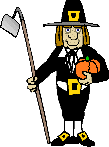| Have a HappyThanksgiving! | ||||
According to tradition, the first American Thanksgiving was celebrated in
1621 by the English Pilgrims who had founded the Plymouth Colony, now in the state of
Massachusetts. The Pilgrims marked the occasion by feasting with their Native American
guests-members of the Wampanoag tribe-who brought gifts of food as a gesture of goodwill.
Although this event was an important part of American colonial history, there is no
evidence that any of the participants thought of the feast as a thanksgiving celebration.
Two years later, during a period of drought, a day of fasting and prayer was changed to
one of thanksgiving because rains came during the prayers. Gradually the custom prevailed
among New Englanders to annually celebrate Thanksgiving after the harvest. Colonial governments and, later, state governments took up the Puritan custom of designating thanksgiving days to commemorate various public events. Gradually the tradition of holding annual thanksgiving holidays spread throughout New England and into other states. During the American Revolution (1775-1783) the Continental Congress proclaimed a national day of thanksgiving following the American victory at the Battle of Saratoga in 1777. U.S. President George Washington proclaimed another day of thanksgiving in 1789 in honor of the ratification of the Constitution of the United States. In 1817 New York State adopted Thanksgiving Day as an annual custom, and many other states soon did the same. Most of the state celebrations were held in November, but not always on the same day.  In the mid-19th century Sarah Josepha Hale, editor of Godey's Ladies Book, led a movement to establish Thanksgiving as a national holiday. In 1863, during the American Civil War (1861-1865), President Abraham Lincoln proclaimed the last Thursday in November Thanksgiving Day in order to bolster the Union's morale. After the war, Congress established Thanksgiving as a national holiday, but widespread national observance caught on only gradually. Many Southerners saw the new holiday as an attempt to impose Northern customs on them. However, in the late 19th century Thanksgiving's emphasis on home and family appealed to many people throughout the United States. As a distinctly American holiday, Thanksgiving was also considered an introduction to American values for the millions of immigrants then entering the country.  During the 20th century, as the population of the United States became increasingly urban, new Thanksgiving traditions emerged that catered to city dwellers. The day after Thanksgiving gradually became known as the first day of the Christmas shopping season. To attract customers, large retailers such as Macy's in New York City and Gimbel's in Philadelphia, Pennsylvania, began to sponsor lavish parades. By 1934 the Macy's parade, featuring richly decorated floats and gigantic balloons, attracted more than one million spectators annually. The custom of watching football games on Thanksgiving Day also evolved during the early decades of the 20th century. As football became increasingly popular in the 1920s and 1930s, many people began to enjoy the holiday at a football stadium. Teams in the National Football League eventually established traditions of playing nationally televised games on Thanksgiving afternoon. In 1939 U.S. President Franklin Roosevelt shifted the day of Thanksgiving from the last Thursday in November to one week earlier. Retail merchants had petitioned the president to make the change to allow for an extra week of shopping between Thanksgiving and Christmas. Many Americans objected to the change in their holiday customs and continued to celebrate Thanksgiving on the last Thursday of the month. Roosevelt's political opponents in Congress also opposed the break with tradition and dubbed the early holiday "Franksgiving." In May 1941 Roosevelt admitted that he had made a mistake and signed a bill that established the fourth Thursday of November as the national Thanksgiving holiday, which it has been ever since.  Thanksgiving is also a legal holiday in Canada. Because Canada is north of the United States, its harvest comes earlier in the year. Accordingly, the Thanksgiving holiday falls earlier in Canada than in the United States. The Canadian Parliament set aside November 6 for annual Thanksgiving observances in 1879. In 1957 the date was shifted to an even earlier day, to the second Monday in October. |
||||
|
||||
| Data is from Encarta Encyclopedia. Holiday pages created by Holiday Fun-2001 |
||||
